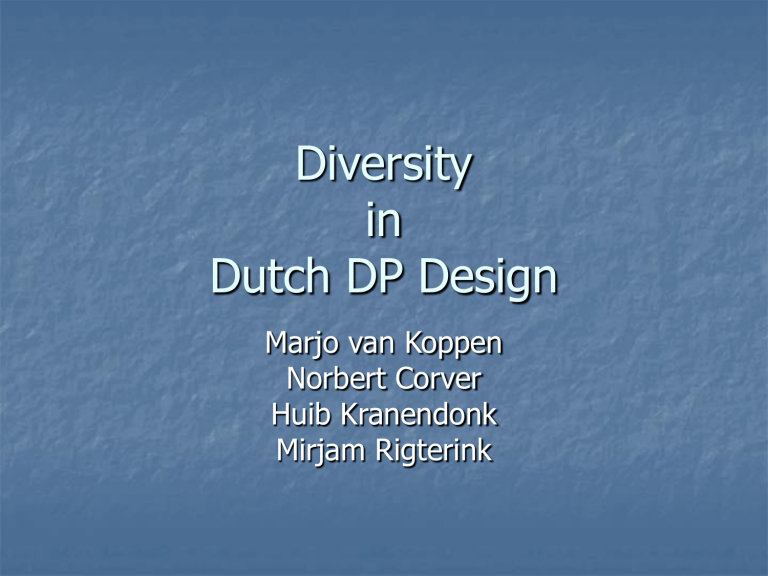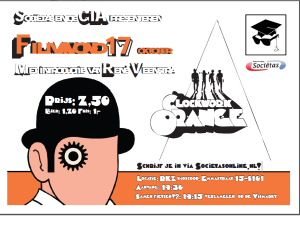
Diversity
in
Dutch DP Design
Marjo van Koppen
Norbert Corver
Huib Kranendonk
Mirjam Rigterink
Diversity in Dutch DP Design (DiDDD)
Project on microvariation in the Dutch Noun Phrase
(see Corver 2004).
Started 01-01-05 at the UiL-OTS, University of
Utrecht, Netherlands.
Project members
Norbert Corver (project leader)
Marjo van Koppen (Postdoc)
Huib Kranendonk (PhD-student)
Mirjam Rigterink (PhD-student)
Outline of this talk
1.
2.
3.
4.
Introduction to the project as a whole: what is
the research domain, what are the research
questions?
Introduction to the subprojects: (i) DP-internal
pronouns, (ii) DP-internal negation and
quantification and (iii) the left periphery of DP.
Outline of the practical side of the project:
what is the intended output of the project,
which steps will be taken to obtain this output?
General information and contact information.
1. Diversity in Dutch DP Design (DiDD)
Research domain
The noun phrase in contemporary variants of Dutch
(dialects) and in older variants of Dutch.
More specific:
Project 1: DP-internal pronouns
Project 2: Negation and quantification in DP
Project 3: Left periphery of DP
Research question
What is the nature of microvariation in the nominal domain
in variants of Dutch?
How can we account for this type of microvariation within
the bounds of the Principles & Parameters model of
language?
1. Diversity in Dutch DP Design
(DiDD)
What is the locus of microvariation in the DP-domain?
Preferably the same as has been identified for the sentential
domain:
The realization of some functional category (cf. among others
Poletto 2000)
The doubly filled comp-filter: i.e. the realization of the head and/or
specifier position of a certain functional projection (cf. among others
Bennis 1997).
The (sub-)feature make up of certain functional heads (cf. among
others Carstens 2002)
The morphological realization of certain functional categories (cf.
among others Van Koppen 2005)
2. DiDDD: Subprojects
Project 1: DP-internal pronouns
Executor: Mirjam Rigterink (PhD-student)
Research Goals
Investigation of (morpho-)syntactic diversity in:
Attributive pronominals within DP
Substantively used pronominals
Articles, demonstratives, possessive
constructions
An example
Articles, demonstratives and ellipsis
(i) a
b
(*den)
the
den
the
deizen
this
deizen
this
bŏom
tree
____
Oerle Dutch
‘this tree’
‘this one’
Generalization: In Oerle Dutch, the article can only cooccur with a
demonstrative in elliptical constructions (cf. De Bont 1962).
But in Bruxelles Dutch: the appearance of the article is not only
dependent on the absence of the head noun, but also on the gender
of the elided noun (cf. Mazereel 1931).
(ii) a
b
den
the
(*et)
the
dane
___
that-m.sg
da
___
that-n.sg
Bruxelles Dutch
‘that one’
‘that one’
Furthermore, in Schouwen-Duivenland Dutch: the appearance of the
article is not only dependent on the absence of the head noun, but
also on the number of the elided noun (cf. De Vin 1916)
(iii)a
b
Neem jij
dan
den
Take
you
then
the
‘Will you then take that one?’
‘ka
(*den) deze
____
I-have the
thesepl ____
‘I took these ones with me.’
diejen
thatsg
___?
___
meejebrocht.
taken
These data raise the following questions:
Why can articles and demonstratives cooccur in certain
varieties of Dutch but not in others?
How can we account for the (variation concerning the)
restrictions on the cooccurence of articles and
demonstratives?
2. DiDDD: Subprojects
Project 2: negation and quantification
Executor: Huib Kranendonk (PhD-student)
Research Goals
Describe and explain the dimensions of variation
concerning quantification and negation, focussing in
particular on:
DP-internal negation
The morpho-syntax of numerals
Partitive constructions
An example
The DP-internal position of numerals and quantifiers
(i)
Present-day standard Dutch
Middle Dutch (Duinhoven 1988)
a zijn vijf
his five
b al zijn
all his
c geen
no
a’
heilige wonden
holy wounds
lieden
people
water
water
b’
c’
zijn heilige wonden vive
his holy
wounds five
sinen lieden
al
his
people all
water negheen
water no
The numerals and quantifiers appear in postnominal position
in Middle Dutch, but not in standard Dutch.
This raises the following questions:
How can we account for the microvariation concerning the
DP-internal positioning of numerals and quantifiers?
Does the Middle Dutch pattern appear in present-day variants
of Dutch?
2. DiDDD: Subprojects
Project 3: The left-periphery of the Dutch Noun Phrase
Executor: Marjo van Koppen (Postdoc)
Research Goals
Investigation
of syntactic diversity in
nominal constructions expressing
interrogation, exclamation and focalization
Investigation of aspects of cross-categorial
parallellism between the nominal and the
sentential system
An example
(i)
The wat voor-construction in Dutch dialects
a
b
Wat
voor boeken heb
je
what
for books have you
‘What kind of books did you buy?’
Wat heb je
voor
boeken
what have you
for
books
gekocht?
bought
standard Dutch
gekocht?
bought
Variation attested in Dutch dialects (data from SAND-project)
‘How’ instead of ‘what’
(ii) Hok for boeken hast
how for books
have.you
For is not present
(iii) Wa
buken
hedde
what books
have.you
kocht?
bought
Oosterbierum Dutch
gekocht?
bought
Leuven Dutch
Reduced inflected form
(iv)
he
have
je
you
gekocht?
bought
Strijen Dutch
‘vukke’ instead of ‘voor’
(v)
Waffer-e
boeke
what.for-infl books
Wat
what
vukke
for
boeken
books
hei
have.you
kocht?
bought
Oostmarsum Dutch
The morphosyntax of wat voor is subject to microvariation in the
contemporary variants of Dutch.
This raises the following questions:
What does the attested microvariation tell us about the
structure of the wat voor-construction and hence about the
structure of DP?
How can we account for the variation discussed above?
Does this construction display the same properties in these
dialects for instance wat voor-split?
3. The practical side
Intended output
two dissertations on microvariation in the DP
one monograph on microvariation in the DP
Two databases concerning microvariation in the DP in
variants of Dutch. These databases will be compatible
with the SAND-database.
A database with data from reference grammars
A database containing the responses to the written
questionnaire
Two workshops: one at the end of 2006, the other at
the end of 2007 (posted on our website, see final
sheet)
3. The practical side
The project will proceed along the following lines:
Step 1: Reference grammar-database: data
from reference grammars of both
contemporary and older variants of Dutch
Step 2: Collect data from other sources, like the
SAND-project.
Step 3: Written questionnaire (based on the
reference grammar database and the other
sources).
Step 4: Oral interviews.
3. The practical side
Reference grammar-database
This database contains the data of reference grammars
concerning both older and contemporary variants of Dutch.
Goals:
i.
to get an idea of which type of constructions concerning the
three subprobjects are attested in variants of Dutch
ii.
to get an idea of which region/period is potentially interesting
for a certain type of construction
iii.
the reference grammar-database both serves as a research
tool and as input for the questionnaire
3. The practical side
Reference grammar-database
At present, the database contains 1768 chunks of data
from 71 reference grammars.
Apart from the data, it also contains comments of the
author of the reference grammar.
You can search this database by
Looking for concrete bits of data. Problem is spelling.
Selecting a subproject: Pronouns, Negation &
Quantification, Left Periphery.
Using (a combination of) keywords. At this point the
keywords are not yet synchronised with those used in
the SAND-project and the Corpus Spoken Dutch.
Selecting a certain period or region.
3. The practical side
The reference grammar database
Data
Project
de miende
the mine-de
Pron
watveurent
LP
Both in
sing and
plur
Veerdalfhondert
“350”
N&Q
Is 350
Uit:
Comments
source
Keywords
Period
Region
Kloeke
Page
subst def art pospron
poss infl endde
Modern
Drenthe
G048p
125
Modern
Drenthe
G048p
131
Modern
Drenthe
G048p
100
subst watvoor endt
Sassen, A. 1953. Het Drents van Ruinen. Dissertation RU
Groningen. Van Gorcum &Comp, Assen
3. The practical side
The questionnaire
Goal of this questionnaire: (i) obtain information
concerning the morpho-syntax of certain
constructions. (ii) serve as input for the oral
interviews.
The set-up of the questionnaire will be similar to
the SAND-questionnaire (cf. Cornips &
Jongenburger 2001). It will contain both
translation questions and completion tasks.
Direct questions on whether sentences are
grammatical will be avoided as much as
possible.
3. The practical side
Methodology of oral interviews
Goal of these interviews: obtain information concerning
the morpho-syntax of certain specific constructions.
Methodology: the methodology of the oral interviews will
also be set up similar to that of the interviews of the
SAND-project (cf. Cornips & Jongenburger 2001): one
dialectspeaker will be instructed so that he can interview
another dialectspeaker. This in order to prevent
accomodation to the interviewer.
The interviews will be recorded. If time allows it, the
interviews will be transcribed.
3. The practical side
Planning
01-01-2005
15-06-2005
30-10-2005
07-01-2006
15-02-2006
15-04-2006
Start of the project
Reference grammar-database
First version questionnaire
Questionnaires sent out to informants
Questionnaires are sent back
Questionnaire-database
June 2006
December 2006
December 2007
31-12-2008
Start with oral interviews
First workshop
Second workshop
End of the project
Practical information
Diversity in Dutch DP Design
DiDDD Website
http://www.let.uu.nl/~mirjam.rigte
rink/personal/dutchdpdesign/
DiDDD e-mail
[email protected]
DiDDD postal address
University of Utrecht/UiL-OTS
Mirjam Rigterink/Microvariation
Trans 10
3512 JK Utrecht
Netherlands
Individual members
Norbert Corver
[email protected]
Marjo van Koppen
[email protected]
Huib Kranendonk
[email protected]
Mirjam Rigterink
[email protected]
References
Bennis, H. (1997). Voegwoordvariaties. In: A. van Santen & M. van der Wal
(red.). Taal in tijd en ruimte. Leiden: SNL.
Bont, A.P. De. (1962). Dialekt van Kempenland. Van Gorcum & Comp.N.V.,
Assen.
Carstens, V. (2003). Rethinking Complementizer Agreement: Agree with a
Case-checked Goal. In: Linguistic Inquiry 34, 393-412.
Cornips, L. & W. Jongenburger (2001). Het design en de methodologie van
het SAND-project. In: Nederlandse Taalkunde 6, pp. 215-232.
Corver, N. (2004). The noun phrase: Diversity in Dutch design and the
design of diversity. Ms. University of Utrecht.
Duinhoven, A.M. (1988). Middelnederlandse syntaxis - synchroon en
diachroon; deel 1: de naamwoordgroep. Martinus Nijhoff, Leiden.
Mazereel, G. (1931). Klank- en vormleer van het Brusselsch dialect met
zijne plaatselijke verscheidenheden. Uitgaven van de Koninklijke Vlaamsche
Academie voor Taal- en Letterkunde 6 (52), Leuven .
Koppen, M. van (2005). One Probe – Two Goals: Aspects of agreement in
Dutch dialects. LOT-dissertations 105. Leiden University.
Poletto, C. (2000). The higher functional field: Evidence from northern
Italian dialects. Oxford University Press.
Vin, A. de. (1916). Het dialect van Schouwen-duiveland. Dissertation
Leiden.












